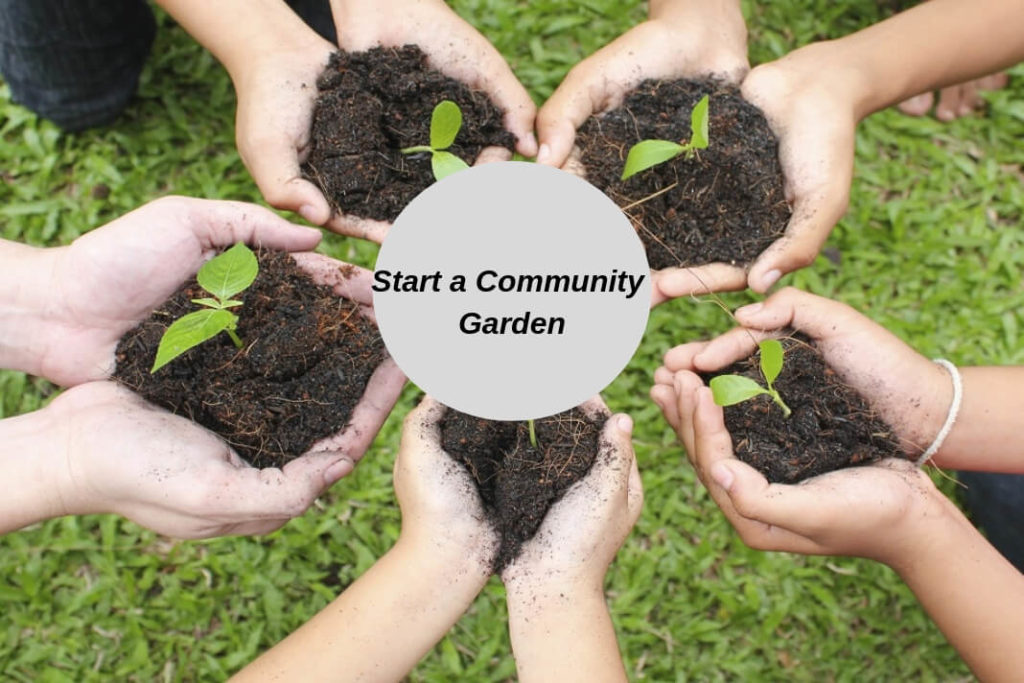
If you want to earn money while contributing something good to the society you live in, start a community garden. A community garden is a great way to bring your neighborhood together. If you have a huge space, you can also grow vegetables, fruits, herbs, and organic flowers. You can even add a children’s play plot and a walking pathway for elders and joggers to make the garden even more special. Your children, when they grow up, would really appreciate your efforts.
However, a lot of energy, motivation, and planning go into raising a garden. You cannot do it alone and so, you will have to set up a committee. If you are serious about this, (and why not give it a try?) this article will help you to plan and plant your community garden.
Step 1: Find Out a Purpose
Before any project is begun or any plan is initiated, a purpose is established. You have to ask yourself if there is any need or desire for a garden. If yes, then what kind of garden is needed. What should the garden serve? For instance, you can develop a kid’s playing garden with swings, merry-go-round and so on, or a place for walking for senior citizens or a place for jogging and freehand exercise for the youngsters, an alternative place to group and gossip for the teens or any reason that is special.
If your community garden is meant for a particular group of people, then people from that group should represent and get involved.
Step 2: Identify the Site
If you already have the plot, skip this step. If you don’t, you will have to find a suitable empty land that receives at least six hours of direct sunlight, for the fruits and vegetables to grow. The land should be a walkable distance from your neighborhood, safe for kids and elderly and should have access to electricity.
That being said, ensure the land you plan to turn it into a community garden has enough water supply and drainage system. Or else, you will have to pipe down water connections, which could be a very lengthy, time-consuming, and expensive process. You will also have to make sure that your project adheres to local zoning laws.
Step 3: Form a Group of Interested People
Community projects can sometimes be lengthy and usually has nil rewards. So, gathering volunteers could be a really tedious job. Not to forget to get the plan up and running. You need volunteers who are dedicated, who are natural social workers, and who are inspiring and have leading abilities. Since charity begins at home, start with a family member. Convince him or her to help in the project. Thereafter, both of you approach your neighbors together and lay down your project plan. Instead of sending out emails and messages, going from door-to-door and talking in person will produce quicker results.
You can also set up a meeting in a town hall or club. This will help you bring the interested parties together and build a garden group out of them. Make sure to walk them through the benefits and goodness that a community garden brings to the society.
Step 4: Determine the Size of the Garden Group
More the people you involve, the quicker will be the plan and plant process. You will need a large group for this project. At the same time, you have to remember that too many heads can spoil the broth. So, you need to balance out and think rationally. We suggest that you cap your garden group to 20 members, each representing one household.
Include only people who are truly willing to commit to work, such as regular water the plants, guard the plot, weed the plot and so on. Each member and each family should understand these responsibilities before joining the group.
Step 5: Form the Committee and Designate Roles
You need to form a committee of people who will take care of Resource Development, Finance, Activities, Construction, Communication, and Coordination. Sit together and allocate people for each role and responsibility.
You will need a president who will coordinate with each family and speak to representing member about arising issues and development plans. He should be a great leader and a good communicator for people to listen and follow him. You can appoint a vice-president so that both can split the governing responsibilities.
Moving on, you would need a treasurer and a financial manager who will have control over the bank account and finance. He will be responsible for water and electricity payments, land leasing, trash disposals, and other infrastructural maintenance bills.
And, you will additionally need a social coordinator who would be responsible for the entertainment aspects, such as organizing events, parties, garden clubs and so on.
A community garden secretary could also be appointed for various other management controls.
These community officers can be re-elected or replaced based on their performances. Each member should vote and mutually elect their officers. Members and volunteers are the most important key to determine the success of a community garden. Therefore, a yearly once the election is a must.
Step 6: Raise Funds and Plan Your Garden Development
Once you have established your garden community, you need to sit together to launch a business plan. Depending upon the size of the plot and the elements you wish to include, your start-up cost will vary. A typical community garden usually costs between $3000 and $6000. You can raise the start-up capital by using several means of fundraising.
- You collect funds from the neighborhoods.
- Ask for donations and sponsors.
- Raise fundraising events by organizing craft fair, the sale of refurbished goods etc.
- Look for online business grants.
- Look for angel investors.
- Apply for crowdfunding.
You would need funds for seeds, manure, plants, gardening tools, construction of pathways, paints, garden chairs, swings and other games for children and other small supplies. You can either ask for funds or ask donators to buy the necessary stuff instead.
Step 7: Get Your Site Insured
You will have to insure the site to safeguard yourself, the landowners, and the members from lawsuits and legal actions. The best type of insurance, which you can purchase, is a liability insurance policy. It protects personal assets from potential lawsuits and covers policyholders from injuries that occur inside the garden. Liability insurance would not cost you much. It should be bought and paid from the monthly garden group allowance.
Step 8: Plan Your Garden
Create a blueprint of the plot and sketch the plan on it. Your group should come up with the rules and regulations about how the garden should run. Rules should cover safety, littering, vandalism, prohibition, and access, rules for children access with and without parents, rules for kids aged from 15 to 18 years, and other rules.
When this is done, you have to decide what should go where in the garden, such as where should be the walking pathway be, where should you add the playground, where the vegetables should grow, where the flowering plants and trees should be planted, where the entrance should be etc.
Start by making the boundaries of the plot. Add a fence to avoid trespassers and vandalism. Install an irrigation system since watering will be the major everyday task associated with your garden. Wire your site for electricity before you start an irrigation system. An automatic irrigation system could be a great idea, such as a sprinkler system. This should not cost you more than USD 3,500.
Step 9: Start With Your Soil
The soil is very important for gardening and growth of plants and trees. Ensure you test your soil drainage. Dig a deep hole in your soil and fill it with water. Fill it again after the first drainage. If the water drains within 15 minutes, it means your soil has good drainage and is ideal for flowering plants and growing trees and vegetables. Anything above an hour indicates bad drainage. You can improve the soil condition with well-rotted manure and good compost.
The pH level is another important element that determines the effective growth of plants and trees. Measure soil samples were taken from different parts of the garden. Your soil pH level must fall anywhere between 6.5 and 8.5 for best growth.
Make the soil clean of debris and weeds. Remove garbage, weeds, uneven soil and rusty and harmful materials. Make sure you wear gloves while doing so. If you are cut by a rusted metal, get yourself a tetanus shot.
Step 10: Plant Your Vegetables, Herbs and, Fruits and Flowers
Traditionally a community garden will have families growing individual plots of fruits and veggies. However, all of you can jointly decide and create a beautiful vegetable garden comprising of most common fruits and vegetables.
Tomatoes, ladies finger, green chilies, lemon, lettuce, green beans, radishes, summer squash are a few common vegetables you can grow as a group of families. Herbs and flowers that you can consider growing are basil, coriander, lavender, parsley, thyme, and rosemary and marigold, chamomile, daisies, nasturtium, and calendula respectively. These flowers attract bees, which is a good sign. You can distribute the yield to all families equally.
Step 11: Maintenance and Nourishments
Allow group members to frequently visit their own vegetable growing spot to water the plants. Schedule how frequently group members should visit the plots, water, and weed. Rotate the responsibilities among your members. Appoint one person who would be visiting the garden once per week to check on the growth and yield, and ensure that no one plucks off vegetables and fruits illegally.
Manage waste effectively. Appoint someone who is an expert in recycling and composting. Learn how to compost, how to check developed seeds, how to manage weeds and how to water plants.
This is all you need to start a community garden. To make the place even more lovely and entertaining, host an annual get-together and share a community meal from the harvested vegetables and herbs. Make the place a family spot and long-lasting. Bring the community together and spread happiness.
If you have any other tips for growing a community garden, which you have applied in your neighborhood and received benefits out of it, do share about it in the comments below.




